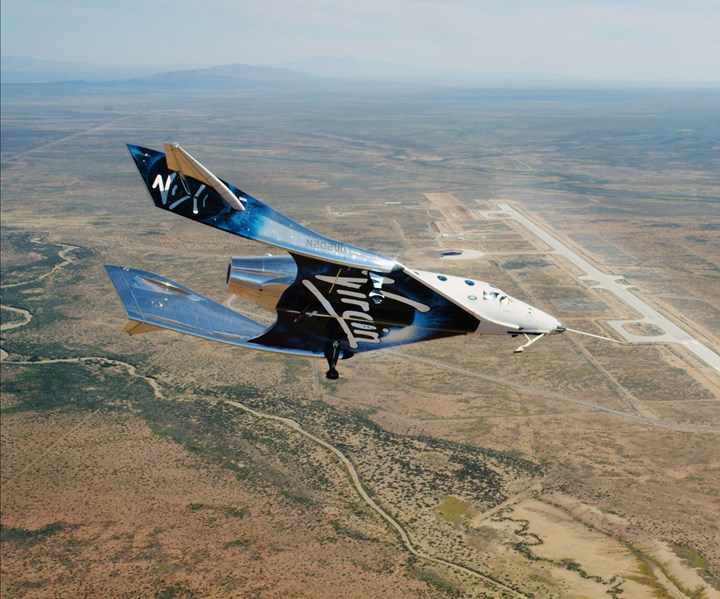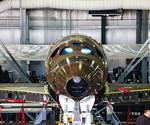SpaceShipTwo completes New Mexico glide test
The VSS Unity’s successfully completed its first flight to test performance and handling characteristics, preparing for eventual commercial use.

Virgin Galactic’s SpaceShipTwo over Spaceport America in New Mexico. Source | Virgin Galactic
Virgin Galactic Holdings Inc. (Mojave, Calif., U.S.) and The Spaceship Co. (Mojave, Calif., U.S.) announced on May 1 the successful completion of its first SpaceShipTwo test flight from Spaceport America, based in Las Cruces, N.M., U.S. This glide flight marks the inaugural solo flight of VSS Unity in New Mexico and is an important flight test milestone in preparation for commercial service.
Boasting an all-carbon fiber composite structure, SpaceShipTwo aims to be the world’s first passenger-carrying spacecraft that has the capability of providing a zero-gravity experience. Despite its unfortunate crash in 2014 during a piloted test flight, Virgin Galactic has continued work on SpaceShipTwo with extensive flight tests progressing towards the ultimate goal of safe space flight.
The May 2020 flight took off from the Spaceport America runway, with VSS Unity attached to the carrier aircraft, VMS Eve. The vehicles climbed to an altitude of 50,000 feet before Unity was released, at which point VSS Unity flew freely for the first time in New Mexico airspace. The spaceship achieved a glide speed of Mach 0.70 and completed multiple test-points, before touching back down smoothly for a runway landing at Spaceport America.
This flight milestone represents a major achievement which has been in the planning since SpaceShipTwo relocated to Virgin Galactic’s New Mexico commercial headquarters in February. Virgin Galactic also fully concluded the relocation of its spaceline operations team and their families to New Mexico.
This glide flight provided the first opportunity to test all the components required to fly the carrier aircraft and spaceship in glide configuration, from a new home base and in new airspace. The pilots performed a series of maneuvers with VSS Unity designed to gather data about performance and handling qualities in order to enhance our aerodynamic modeling and verify against similar maneuvers that were performed earlier in Unity’s test flight program. The flight test also provided an opportunity for the pilots and spaceflight operations team to continue familiarization with the new airspace around the Gateway to Space and a chance to capture valuable in-flight data and conduct further pilot training.
Related Content
-
McLaren celebrates 10 years of the McLaren P1 hybrid hypercar
Lightweight carbon fiber construction, Formula 1-inspired aerodynamics and high-performance hybrid powertrain technologies hallmark this hybrid vehicle, serve as a springboard for new race cars.
-
Cryo-compressed hydrogen, the best solution for storage and refueling stations?
Cryomotive’s CRYOGAS solution claims the highest storage density, lowest refueling cost and widest operating range without H2 losses while using one-fifth the carbon fiber required in compressed gas tanks.
-
Sulapac introduces Sulapac Flow 1.7 to replace PLA, ABS and PP in FDM, FGF
Available as filament and granules for extrusion, new wood composite matches properties yet is compostable, eliminates microplastics and reduces carbon footprint.
















